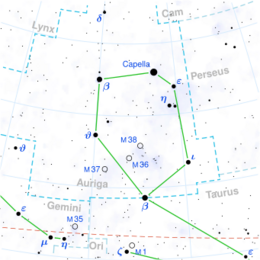Upsilon Aurigae
Topic: Astronomy
 From HandWiki - Reading time: 3 min
From HandWiki - Reading time: 3 min
| Observation data Equinox J2000.0]] (ICRS) | |
|---|---|
| Constellation | Auriga |
| Right ascension | 05h 51m 02.43804s[1] |
| Declination | +37° 18′ 20.0581″[1] |
| Apparent magnitude (V) | 4.74[2] |
| Characteristics | |
| Evolutionary stage | Asymptotic giant branch[3] |
| Spectral type | M0 III[4] |
| U−B color index | +1.93[2] |
| B−V color index | +1.62[2] |
| R−I color index | 1.07 |
| Variable type | Suspected[5] |
| Astrometry | |
| Radial velocity (Rv) | +37.68[6] km/s |
| Proper motion (μ) | RA: +35.914[1] mas/yr Dec.: −46.100[1] mas/yr |
| Parallax (π) | 6.5040 ± 0.3305[1] mas |
| Distance | 500 ± 30 ly (154 ± 8 pc) |
| Absolute magnitude (MV) | −1.28[7] |
| Details[8] | |
| Mass | 1.64±0.22 M☉ |
| Radius | 74.2+8.7 −7.0 R☉ |
| Luminosity | 1,165±250 L☉ |
| Surface gravity (log g) | 1.16+0.04 −0.08[9] cgs |
| Temperature | 3,912±52 K |
| Age | 1.98±0.68 Gyr |
| Other designations | |
| Database references | |
| SIMBAD | data |
Upsilon Aurigae, Latinised from υ Aurigae, is the Bayer designation for a single[11] star in the northern constellation of Auriga. It has an apparent visual magnitude of 4.74,[2] which means it is bright enough to be seen with the naked eye. Based upon parallax measurements, this star is approximately 500 light-years (150 parsecs) distant from the Earth. It is drifting further away with a radial velocity of +38 km/s.[6]
This is an evolved red giant star with a stellar classification of M0 III.[4] It is a suspected variable star[5] and is currently on the asymptotic giant branch, which means it is generating energy through the fusion of helium along a shell surrounding a small, inert core of carbon and oxygen.[3] The star is two billion years old with 1.64 times the mass of the Sun and has expanded to 61 times the Sun's radius. It is radiating 1,165 times the Sun's luminosity from its photosphere at an effective temperature of 3,912 K.[8]
References
- ↑ 1.0 1.1 1.2 1.3 1.4 Brown, A. G. A. (August 2018). "Gaia Data Release 2: Summary of the contents and survey properties". Astronomy & Astrophysics 616: A1. doi:10.1051/0004-6361/201833051. Bibcode: 2018A&A...616A...1G. Gaia DR2 record for this source at VizieR.
- ↑ 2.0 2.1 2.2 2.3 Johnson, H. L. et al. (1966), "UBVRIJKL photometry of the bright stars", Communications of the Lunar and Planetary Laboratory 4 (99): 99, Bibcode: 1966CoLPL...4...99J
- ↑ 3.0 3.1 Eggen, Olin J. (July 1992), "Asymptotic giant branch stars near the sun", Astronomical Journal 104 (1): 275–313, doi:10.1086/116239, Bibcode: 1992AJ....104..275E.
- ↑ 4.0 4.1 Keenan, Philip C.; Barnbaum, Cecilia (June 1999), "Revision and Calibration of MK Luminosity Classes for Cool Giants by HIPPARCOS Parallaxes", The Astrophysical Journal 518 (2): 859–865, doi:10.1086/307311, Bibcode: 1999ApJ...518..859K.
- ↑ 5.0 5.1 Hamada, K. et al. (January 1979), "On the Variability of upsilon Aurigae", Information Bulletin on Variable Stars 1531: 1, Bibcode: 1979IBVS.1531....1H.
- ↑ 6.0 6.1 Famaey, B. et al. (January 2005), "Local kinematics of K and M giants from CORAVEL/Hipparcos/Tycho-2 data. Revisiting the concept of superclusters", Astronomy and Astrophysics 430 (1): 165–186, doi:10.1051/0004-6361:20041272, Bibcode: 2005A&A...430..165F.
- ↑ Anderson, E.; Francis, Ch. (2012), "XHIP: An extended hipparcos compilation", Astronomy Letters 38 (5): 331, doi:10.1134/S1063773712050015, Bibcode: 2012AstL...38..331A.
- ↑ 8.0 8.1 Baines, E. et al. (2017), "Fundamental Parameters of 87 Stars from the Navy Precision Optical Interferometer", The Astronomical Journal 155 (1): 30, doi:10.3847/1538-3881/aa9d8b, Bibcode: 2018AJ....155...30B.
- ↑ Takagi, Yuhei et al. (June 2011), "Age Determinations of Early-M Type Pre-Main Sequence Stars Using a High-Resolution Near-Infrared Spectroscopic Method", Publications of the Astronomical Society of Japan 63 (3): 677–684, doi:10.1093/pasj/63.3.677, Bibcode: 2011PASJ...63..677T.
- ↑ "* ups Aur". SIMBAD. Centre de données astronomiques de Strasbourg. http://simbad.u-strasbg.fr/simbad/sim-basic?Ident=%2A+ups+Aur.
- ↑ Eggleton, P. P.; Tokovinin, A. A. (September 2008), "A catalogue of multiplicity among bright stellar systems", Monthly Notices of the Royal Astronomical Society 389 (2): 869–879, doi:10.1111/j.1365-2966.2008.13596.x, Bibcode: 2008MNRAS.389..869E.
External links
 |
 KSF
KSF
